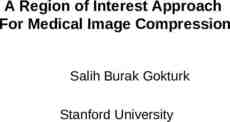Chapter 7 “Ionic and Metallic Bonding”
88 Slides2.60 MB

Chapter 7 “Ionic and Metallic Bonding”

7.1 - Ions

Valence Electrons are ? Valence electrons – The s and p electrons in the outer energy level – the highest occupied energy level Core electrons – electrons in the energy levels below.

Keeping Track of Electrons Atoms in the same column. 1) Have the same outer electron configuration. 2) Have the same valence electrons. 1) Electron configuration of Group 1A? 2) Number of valence electrons in Group 1A? – 1

The number of valence electrons are easily determined. It is the group number for a representative element Group 2A: Be, Mg, Ca, etc. – have 2 valence electrons

Electron Dot diagrams are A way of showing valence electrons. How to write them? Write the symbol – represents the nucleus and inner (core) electrons Put one dot for each valence electron (8 maximum) They don’t pair up until they have to (Hund’s rule) X

The Electron Dot diagram for Nitrogen Nitrogen has 5 valence electrons to show. First we write the symbol. Then add 1 electron at a time to each side. Now they are forced to pair up. We have now written the electron dot diagram for Nitrogen. N

Practice with e- dot structure Li N Be O B F C Ne

The Octet Rule The Octet Rule: in forming compounds, atoms tend to achieve a noble gas configuration; 8 in the outer level Each noble gas (except He, which has 2) has 8 electrons in the outer level

Formation of Cations Metals lose electrons to attain a noble gas configuration. – Where are metals located? Left Make positive ions (cations)

Formation of Cations If we look at the electron configuration, it makes sense to lose electrons: Na 1s22s22p63s1 1 valence electron Na1 1s22s22p6 This is a noble gas configuration with 8 electrons in the outer level.

Electron Dots For Cations Metals will have few valence electrons (usually 3 or less); calcium has only 2 valence electrons Ca

Electron Dots For Cations Metals will lose all valence electrons Ca

Electron Dots For Cations Metals will lose the valence electrons Form positive ions Ca 2 This is the “calcium ion”. NO DOTS are now shown for the cation.

Practice # of valence electron Na 1 Mg 2 Al 3 Cation formed

The transition metals get funky

Electron Dots For Cations Let’s do Scandium, #21 The electron configuration is: 1s22s22p63s23p64s23d1 Thus, it can lose 2e- (making it 2 ), or lose 3e(making 3 ) Sc Sc2 Sc Sc3 Scandium (II) ion Scandium (III) ion

Electron Dots For Cations Let’s do Silver, element #47 Predicted configuration is: 1s22s22p63s23p64s23d104p65s24d9 Actual configuration is: 1s22s22p63s23p64s23d104p65s14d10 Ag Ag1 (can’t lose any more, charges of 3 or greater are uncommon)

Electron Dots For Cations Silver did the best job it could, but it did not achieve a true Noble Gas configuration Instead, it is called a “pseudo-noble gas configuration”

Electron Configurations: Anions Nonmetals gain electrons to attain noble gas configuration. They make negative ions (anions) S 1s22s22p63s23p4 6 valence electrons S2- 1s22s22p63s23p6 noble gas configuration. Halide ions - ions from chlorine or other halogens that gain electrons

Electron Dots For Anions Nonmetals will have many valence electrons (usually 5 or more) They will gain electrons to fill outer shell. P 3- (This is called the “phosphide ion”, and shows dots)

Stable Electron Configurations All atoms react to try and achieve a noble gas configuration. Noble gases have 2 s and 6 p electrons. 8 valence electrons stable This is the octet rule (8 in the outer level is particularly stable). Ar

Review How many valence electrons do the following elements have? Ga 3 P 5 Cl 7 S 6 Mg 2 K 1 Li 1 He 2 F 7 Ne 8

Review Draw the electron dot structure of the following elements. Ga K P He S F Mg Ne

Review What ions will the following elements form?

7.2 - Ionic Bonds and Ionic Compounds

Ionic Bonding Anions and cations are held together by opposite charges ( and -) Ionic compounds are called salts. Formula unit – Simplest ratio of elements in an ionic compound.

Practice with Formula Unit What is the formula unit for the following compounds? Formula Unit NaCl 1:1 2:1 1:1:3

Ionic Bonds Formed through the transfer of electrons (lose and gain) Electrons are transferred to achieve noble gas configuration.

Ionic Compounds 1) Also called SALTS 2) Made from a CATION and ANION A metal and a nonmetal)

Ionic Bonding Na Cl The metal loses its one electron from the outer level. The nonmetal gains one more to fill its outer level, and will accept the one electron that the metal is going to lose.

Ionic Bonding Na Cl - Note: Remember that NO DOTS are now shown for the cation!

Ionic Bonding Example- combine Ca and P: Ca P All electrons must be accounted for, and each atom will have a noble gas configuration (which is stable).

Ionic Bonding Ca P

Ionic Bonding Ca 2 P

Ionic Bonding Ca 2 Ca P

Ionic Bonding Ca 2 Ca P 3-

Ionic Bonding Ca 2 Ca P P 3-

Ionic Bonding Ca 2 Ca 2 P P 3-

Ionic Bonding Ca 2 Ca P Ca P 2 3-

Ionic Bonding Ca 2 Ca P Ca P 2 3-

Ionic Bonding Ca 2 Ca 2 Ca 2 P 3- P 3-

Ionic Bonding Ca3P2 Chemical formulashows the kinds and numbers of atoms in the smallest representative particle of the substance.

Balancing Ionic formulas Crisscross method The numerical value of the charge of each ion is crossed over and becomes the subscript for the other ion.

Practice What will the chemical formula look like? Elements Ca 2 F- Al 3 O-2 Ca 2 O-2 Formula

Properties of Ionic Compounds 1. Crystalline solids – regular repeating arrangement of ions Strongly bonded together. Structure is rigid. 2. High melting points Coordination numbernumber of ions of opposite charge surrounding it

- Page 198 Coordination Numbers: NaCl Both the sodium and chlorine have 6 CsCl Both the cesium and chlorine have 8 TiO2 Each titanium has 6, and each oxygen has 3

Do they Conduct? Conducting electricity means allowing charges to move. In a solid, the ions are locked in place. Ionic solids are insulators. When melted, the ions can move. 3. Melted ionic compounds conduct. – NaCl: must get to about 800 ºC. – Dissolved in water, they also conduct (free to move in aqueous solutions)

- Page 198 The ions are free to move when they are molten (or in aqueous solution), and thus they are able to conduct the electric current.

Review What is the formula unit for the following compounds? KCl 1:1 2:3 1:2 1:1:4 HgS 1:1 2:1

Practice What will the chemical formula look like? Elements Na ClMg 2FCa 2 N-3 Al 3 N-3 K S-2 Formula

7.3 – Bonding in Metals

Metallic Bonds are How do we get sheets of Aluminum (or any metal)? Metals hold on to their valence electrons very weakly. Think of them as positive ions (cations) floating in a sea of electrons

Sea of Electrons Electrons are free to move through the solid. Metals conduct electricity.

Metals are Malleable Hammered into shape (bend). Ductile - drawn into wires. Both malleability and ductility explained in terms of the mobility of the valence electrons

- Page 201 Due to the mobility of the valence electrons, metals have: 1) Ductility and 2) Malleability Notice that the ionic crystal breaks due to ion repulsion!

Malleable Force

Malleable Mobile electrons allow atoms to slide by, sort of like ball bearings in oil. Force

Ionic solids are brittle Force - -

Ionic solids are brittle Strong Repulsion breaks a crystal apart, due to similar ions being next to each other. Force - - - - -

Crystalline structure of metal Metals are arranged in very compact and orderly patterns.

Alloys Alloys - mixtures of 2 or more elements, at least 1 is a metal Made by melting a mixture of elements, then cooling Brass: an alloy of Cu and Zn Bronze: Cu and Sn

Why use alloys? Properties are often superior to the pure element Sterling silver (92.5% Ag, 7.5% Cu) is harder and more durable than pure Ag, but still soft enough to make jewelry and tableware Steels are very important alloys – corrosion resistant, ductility, hardness, toughness, cost

The END

Predicting Ionic Charges Group B elements: Many transition elements have more than one possible oxidation state. Note the use of Roman Iron (II) Fe2 numerals to show charges Iron (III) Fe3

Naming cations Two methods can clarify when more than one charge is possible: 1) Stock system – uses roman numerals in parenthesis to indicate the numerical value 2) Classical method – uses root word with suffixes (-ous, -ic) Does not give true value

Naming cations We will use the Stock system. Cation - if the charge is always the same (like in the Group A metals) just write the name of the metal. Transition metals can have more than one type of charge. – Indicate their charge as a roman numeral in parenthesis after the name of the metal (Table 9.2, p.255)

Predicting Ionic Charges Some of the post-transition elements also have more than one possible oxidation state. Tin (II) Sn2 Lead (II) Pb2 Tin (IV) Sn4 Lead (IV) Pb 4

Predicting Ionic Charges Group B elements: Some transition elements have only one possible oxidation state, such as these three: Silver Ag1 Zinc Zn2 Cadmium Cd2

Exceptions: Some of the transition metals have only one ionic charge: –Do not need to use roman numerals for these: –Silver is always 1 (Ag1 ) –Cadmium and Zinc are always 2 (Cd2 and Zn2 )

Practice by naming these: Na1 Ca2 Al3 Fe3 Fe2 Pb2 Li1

Write symbols for these: Potassium ion Magnesium ion Copper (II) ion Chromium (VI) ion Barium ion Mercury (II) ion

Naming Anions Anions are always the same charge Change the monatomic element ending to – ide F1- a Fluorine atom will become a Fluoride ion.

Practice by naming these: Cl1 N3 Br1 O2 Ga3

Write symbols for these: Sulfide ion Iodide ion Phosphide ion Strontium ion

Polyatomic ions are Groups of atoms that stay together and have an overall charge, and one name. Usually end in –ate or -ite Acetate: C2H3O21- Nitrate: NO31- Nitrite: Permanganate: MnO41- Hydroxide: OH1- and Cyanide: CN1-? NO21-

Know Table 9.3 on page 257 Sulfate: SO 24 Sulfite: SO 23 3Phosphate: PO4 Phosphite: PO 33 Carbonate: CO32Chromate: CrO42- Ammonium: NH41 (One of Dichromate: Cr O 22 7 theion few If the polyatomic positive begins with H, then polyatomic

Writing Ionic Compound Formulas Example: Barium 2 ( 1. Write the ) Ba nitrate (note the 2 NO3 formulas for word name) 2. Check to see Now Ba(NO ) Not the cation if charges are balanc 3. Balance balance and anion, balanced. ed. charges , if d! including 3 2 2

Writing Ionic Compound Formulas Example: Ammonium 2( ) NH4 2 SO4 1. Write the sulfate (note the 2 word formulas for Now 2. Check to name) (NH ) SO Not the cation balanc see if 3. Balance balance and anion, ed. charges are , if d! including balanced. 4 2 4

Writing Ionic Compound Formulas Example: Iron (III)3 1. Write the Fe Cl 3 chloride (note the 2 formulas for Now balanced. word name) 2. Check to FeCl Not the cation see if 3. Balance balance and anion, charges are , if d! including balanced. 3
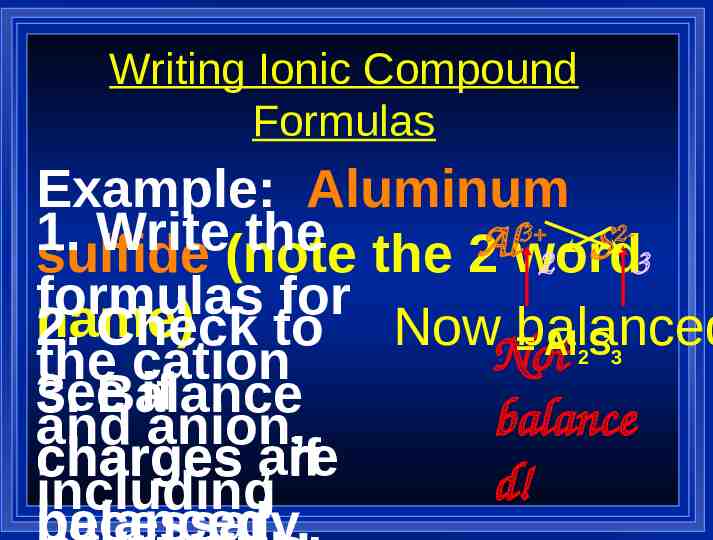
Writing Ionic Compound Formulas Example: Aluminum 3 21. Write the Al S sulfide (note the 2 word 2 3 formulas for name) 2. Check to NowNot balanced Al S the cation see if 3. Balance balance and anion, charges are , if d! including balanced. 2 3

Writing Ionic Compound Formulas Example: Magnesium 2 2Mg CO3 1. Write the carbonate formulas for 2. Check to They are the cation MgCO see if balanced! and anion, charges are including (note the 2 word name) 3

Writing Ionic Compound Formulas Example: Zinc 2 ( 1. Write the ) Zn OH hydroxide (note the 2 2 formulas for word name) Now balanced. 2. Check to see Zn(OH) Not the cation if charges 3. Balance are balance and anion, balanced. charges , if d! including 2

Writing Ionic Compound Formulas Example: Aluminum 3 31. Write the Al PO 4 phosphate formulas for 2. Check to seeThey ARE the cation AlPO if charges are balanced! and anion, balanced. including (note the 2 word name) 4
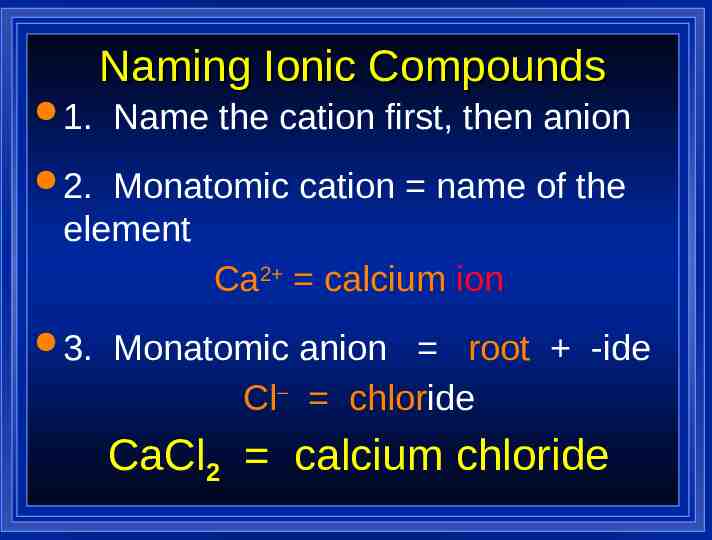
Naming Ionic Compounds 1. Name the cation first, then anion 2. Monatomic cation name of the element Ca2 calcium ion 3. Monatomic anion root -ide Cl- chloride CaCl2 calcium chloride
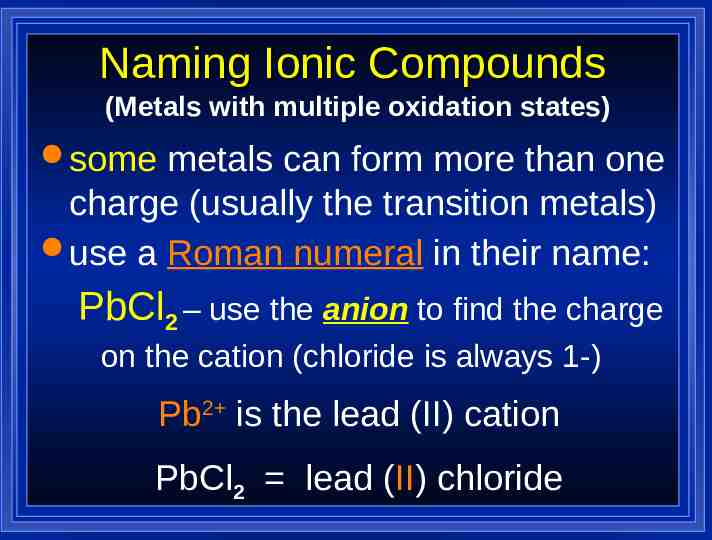
Naming Ionic Compounds (Metals with multiple oxidation states) some metals can form more than one charge (usually the transition metals) use a Roman numeral in their name: PbCl2 – use the anion to find the charge on the cation (chloride is always 1-) Pb2 is the lead (II) cation PbCl2 lead (II) chloride
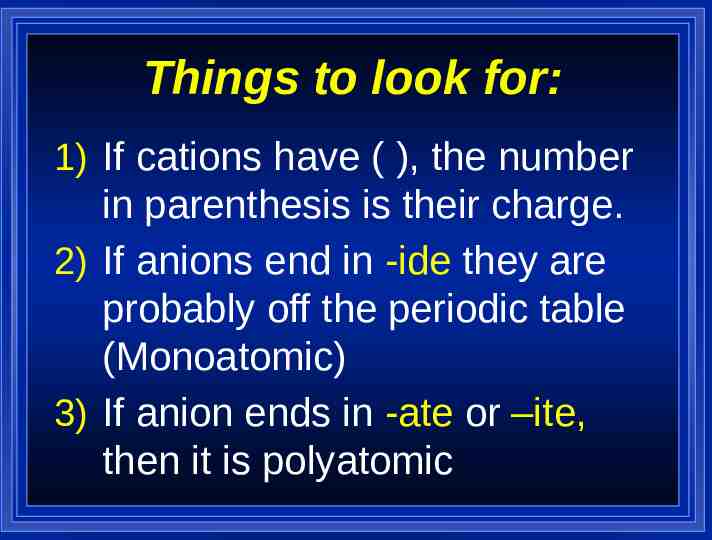
Things to look for: 1) If cations have ( ), the number in parenthesis is their charge. 2) If anions end in -ide they are probably off the periodic table (Monoatomic) 3) If anion ends in -ate or –ite, then it is polyatomic

Practice by writing the formula or name as required Iron (II) Phosphate Stannous Fluoride Potassium Sulfide Ammonium Chromate MgSO 4 FeCl 3




